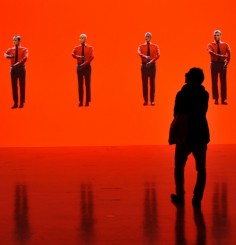KRAFTWERK
كرافتفرك
קראפטוורק
クラフトワーク
ource: modernamuseet
En sal är ägnad Kraftwerks 3-D-installation 1 2 3 4 5 6 7 8 (2013). Med roboten som konstnärligt alter ego och visuella 3-D-element, har Kraftwerk har sedan det tidiga 1970-talet i multidisciplinära projekt och performances utforskat relationen mellan människa och maskin.
.
.
.
.
.
.
.
source: museografo
Kraftwerk, grupo pionero de la música electrónica originarios de Dusseldorf, Alemania. 1 2 3 4 5 6 7 8, nombre que le dieron a la pieza los fundadores Ralph Hütter y Florian Schneider, es una edición que presenta una retrospectiva de sus ocho álbumes en orden cronológico, desde Autobahn a Tour de France. La muestra se presenta como una video-instalación en la que los espectadores tienen que pasar con lentes de 3D para apreciar la sincronización de la música y las imágenes.
.
.
.
.
.
.
.
source: lofficiel-hommes
Insgesamt hat Deutschland nach dem 2. Weltkrieg kaum Musik hervorgebracht, die die Welt im großen Stil verändert hat – mit Ausnahme von Kraftwerk. Die Düsseldorfer Band lieferte die Blaupause für Hiphop, Elektro, den Synth-Pop der Achtziger und die große Technowelle der Neunziger. Vom Rheinland aus schrieben Kraftwerk die Musikgeschichte um und ihr Einfluss reicht bis in die Gegenwart – zum Vocoder-Rap von Kanye West zum Beispiel.
Doch es war nicht nur ihre musikalische Experimentierfreude, die Ralf Hütter und Florian Schneider auszeichnete. Auch die Präsentation ihrer Musik trug entscheidend dazu bei, dass aus Kraftwerk auch visuell eine ikonische Band wurde. Dem Hippie-Look und der Laissez Faire der Siebziger setzten Sie eine Computerwelt entgegen, in der sich die Mitglieder der Band kleideten wie uniformierte Ingenieure aus einem Science-Fiction-Film.
Deshalb macht es durchaus Sinn, dass Kraftwerk in den letzten Jahren nicht so sehr in der Pop-, sondern vor allem in der Kunstwelt wieder entdeckt werden. Kraftwerkt Auftritte waren von Anfang an immer auch multimediale Performances – eine Übung in der Zusammenführung von Mensch und Maschine. Auch hier ist die Band also stilbildend gewesen. Als letztes entdeckten Hütter und Schneider 3D für sich. 2011 installierten sie eine 3D-Installation im Lehnbachhaus in München. 2012 folgten die großen 3D-Konzerte im MoMA. Für ihre erste Galerieausstellung bei Sprüth Magers in Berlin, entwickelte die Band eine weitere 3D-Installation, die allerdings nur noch bis zum 31. August zu sehen ist. Der Titel “12345678″ bezieht sich auf die wichtigsten Alben aus ihrem Werk und deutet an, dass sich der Besuch allein wegen des Streifzugs durch die beeindruckende Bandgeschichte lohnt, die sich hier entfaltet.
.
.
.
.
.
.
.
source: artinfo
After their string of sold out performances at MoMA, P.S.1, the Kunstsammlung NRW, and the Tate Modern, and hit exhibition at Munich’s Lenbachhaus, German electro pioneers Kraftwerk have come to Berlin for their first ever gallery show. For Sprüth Mager’s cavernous main exhibition space, the quartet has retooled the videos used in those performances, “The Catelogue” into a low-fi 3D, three-channel video installation.
Moving into the gallery is something of a homecoming for the band. Founders, Ralf Hütter and Florian Schneider, took to numerous galleries, off-spaces, and institutions throughout the Dusseldorf and the Rhineland at large for informal performances during the area’s avant-garde boom in the 70s. “1 2 3 4 5 6 7 8” includes some of those early efforts, presenting an over 40 minute long loop of “Autobahn” (1974), “Radio-Activity” (1975), “Trans Europe Express” (1977), “The Man-Machine” (1978), “Computer World” (1981), “Techno Pop” (1986), “The Mix” (1991), “Tour de France” (2003) edited together earlier this year specifically for the Berlin exhibition.
.
.
.
.
.
.
.
source: artsy
Founded by Ralf Hütter and Florian Schneider in the climate of experimental 1960s and ’70s Dusseldorf, the enormously influential multimedia project Kraftwerk have been creating groundbreaking electronic music and performing audio-visual events in museums and galleries for decades, encompassing a unique form of artistic practice. Kraftwerk created the legendary Kling Klang studio in Dusseldorf, where the group conceived and composed their albums, experimenting with tapes, synthesizers, robotic rhythms, computer-speech technology, and other cutting-edge technologies. Concerned with the interaction between humans and machines, and the escalating computerization of human culture, Kraftwerk often replace themselves with signature robots during live performances, positioned in front of a backdrop of digital visuals that are characterized by striking abstract and graphic imagery. Kraftwerk recently performed 12345678 (2012–3), a landmark series of events that acted as a live retrospective of their work at the Tate in London, MoMA in New York, and Kunstsammlung NRW in Dusseldorf.


